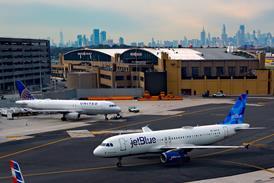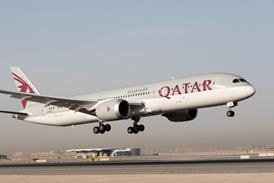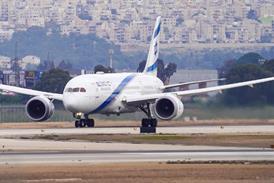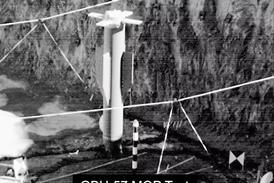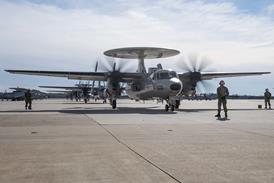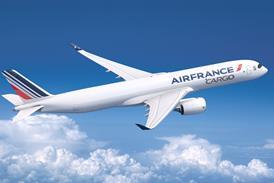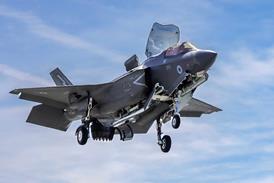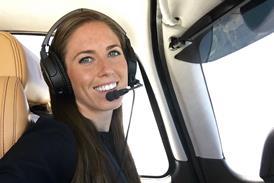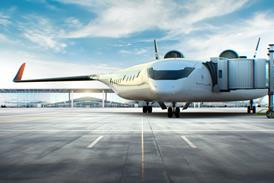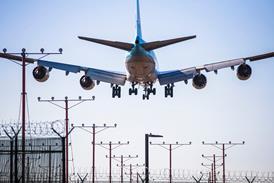High above the Persian Gulf, a rookie fighter pilot prepares to rendezvous with a tanker aircraft to refuel mid-flight.
Several miles away, the tanker appears on radar, but can also be seen visually as a small speck on the horizon, above the fighter’s cockpit canopy.
As the new pilot matches course to close with the tanker, it slowly comes into focus: a single vertical stabiliser pierced by a turbofan engine, two more engines mounted underwing, and critically a fuel transfer boom being lowered.
The thin tube is clearly identifiable protruding downward from the Boeing KC-10’s grey fuselage; silhouetted against a blue-and-white of surrounding clouds and sky.
Unfortunately, our novice pilot has yet to master throttle control. Failing to reduce airspeed at the appropriate moment, the fighter accelerates past the tanker, which drifts by above and to the right of the cockpit with its refuelling boom still extended.
A brash attempt at overcorrection involving more unsuccessful throttle management and a sweeping lefthand turn fails to appropriately reposition the fighter for fuel transfer, and the tanker is lost amongst the clutter of brown desert mountains and blue sea below.
That pilot was FlightGlobal’s reporter, regrettably failing at a first aerial refuelling attempt.
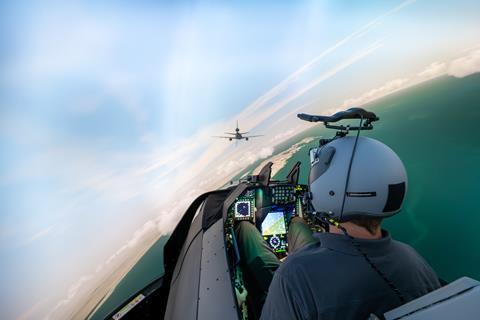
A subsequent attempt at air-to-ground bombing was marginally more successful, but the spectre of poor throttle management returned during landing – necessitated by the failure to take on fuel – resulting in a large fireball several hundred metres short of the runway apron.
Fortunately, no real aviators or bystanders were harmed in the accident, which took place inside one of Lockheed Martin’s latest Block 70/72 F-16 flight simulators.
During a recent visit to Lockheed’s training and logistics solutions centre in Orlando, Florida, FlightGlobal was given the opportunity to test out the company’s latest F-16 simulator, which offers a fully representative cockpit, ultra-high resolution graphics and motion processing smooth enough to replicate highly dexterous tasks like in-flight refuelling.
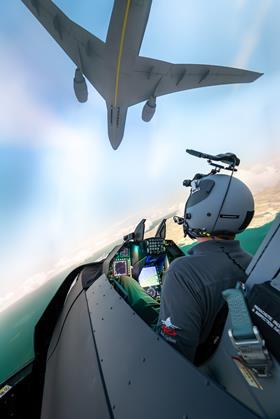
Known as the Full Mission Trainer (FMT), the domed system offers an immersive experience for both new and experienced pilots to drill on basic flight procedures or rehearse specific missions before climbing into a real cockpit – all powered by a physics engine that generates realistic flight dynamics and threat reactions.
A network of laser projectors cast high-resolution video on all sides of the simulator’s full-scale cockpit, which can be networked to other FMT domes and smaller, less immersive pilot stations that can be used for generating adversary air or rehearsing group manoeuvres in real time.
The laser projectors offer a major improvement over the high-resolution bulb projectors used in other simulators. In addition to having significantly longer lifespans and lower operating costs, the laser projectors are not susceptible to misalignment, which are common in bulb projector systems and can take hours to remedy.
All imagery within the FMT is simultaneously projected in visible light and infrared, allowing for a quick and easy transition to practising flying in low-light conditions with night-vision goggles.
Lockheed says the FMT represents a monumental leap in both capability and value over both its older F-16 simulators and the products offered by third-party competitors.
“A simulator is about getting you ready for the airplane,” says Eric Carney, a former Boeing C-17 pilot in the US Air Force (USAF) who is now Lockheed’s director of strategy and business development for training and logistics solutions.
He says the simulators he used in uniform were woefully inadequate when it came to replicating the two most critical events for a C-17 pilot: aerial refuelling and assault landings.
“The two most critical events in the airplane, that were hardest on the airplane and that you want to do in the simulator, it’s where the simulator was the absolute worst,” Carney notes.
That undesirable outcome was the result of a simulator model that did not exactly match the C-17’s real world flight control system – resulting in students flying the simulator differently than they did the actual aircraft.
Lockheed says the FMT avoids this pitfall by building the simulator around the same software and flight control models used on the actual F-16. This also allows the FMT to fully integrate all of the weapons and sensors carried by physical F-16s.
Lockheed believes this represents one of the system’s great advantages over third-party simulators, which can only replicate the software to which Lockheed has direct access as the prime manufacturer.
Earlier simulators also lacked the ability to effectively reproduce ultra-niche tasks like aerial refuelling at night, forcing crews to drill on those difficult manoeuvres in the real world – raising both the risk and cost of developing those skills.
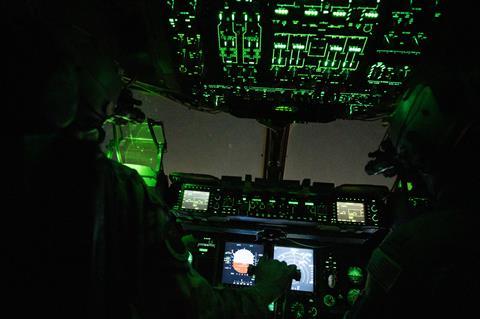
Flying the FMT in night mode, FlightGlobal experienced the deadly phenomenon wherein the star-filled sky, viewed through night-vision goggles, becomes indistinguishable from the ocean below, which is reflecting that starlight.
The resulting disorientation and loss of spatial awareness – rendered perfectly in the FMT simulation – can be (and has been) deadly for pilots.
“It’s very scary,” says Aaron Gibson, a former USAF F-16 pilot who served as instructor pilot for FlightGlobal’s ill-starred sortie.
For such instances, both the actual F-16 and its FMT digital twin have an auto recovery system. With the push of a button, the pilot can go fully hands off the flight controls and the aircraft will correctly reorient itself, before returning control to the operator.
Gibson says the system has saved the lives of several US aviators in the real world.
In addition to the performance attributes of the simulator itself, the FMT also features a digital management system that allows for rapid scenario development and seamless after action reviews post-flight – both of which can take hours to execute with legacy training systems.
“If I could make one reason for a customer to buy this system, it would be this,” Gibson says. “It saves so much time and is so much more effective for your training.”
The digital system automatically flags and timestamps violations of mission parameters and safety restrictions, such as altitude or airspeed limits, allowing instructors to easily review key portions of the flight with students.
“Believe it or not, this is where you get most of your learning,” Gibson says. “Debrief is where the learning happens.”
The high degree of realism offered by the FMT system allows frontline operators to perform much more of their training in the simulator, generating significant savings on expenses like fuel.
Lockheed says one USAF fighter wing reported saving $7 million per pilot per year through the introduction of the FMT simulator.
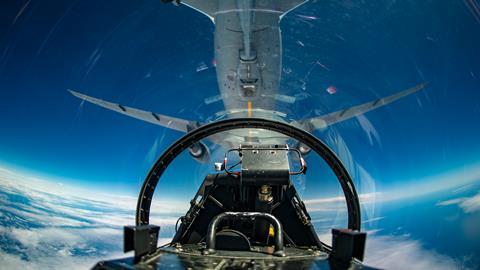
The smaller flight stations that pair with the FMT, which Lockheed calls Weapon Tactic Trainers (WTTs), can also offer significant benefits to operators. These include the F-16 cockpit, but use simple flat panel screens in the forward field of view, rather than the fully immersive dome.
They offer a lower-cost option to supplement FMT domes, but can also be effective trainers in their own right. Gibson describes the WTT stations as an “invaluable” way for pilots to quickly and easily refresh on critical in-flight procedures.
“I don’t remember how it works when I run out of oil,” he says as an example. “I can just run through it, all by myself. Twenty minutes later, I’ve done four practice runs.”
The highly customisable simulation environment also allows frontline operators to create the exact conditions they might expect to face on an upcoming mission, such as moon phase, cloud cover and illumination level.
Lockheed is targeting the FMT system for operators of new-build F-16 Block 70/72 jets and existing customers upgrading their older aircraft to the latest F-16V standard.
The company has an order backlog of 114 Block 70/72 F-16s, 26 of which have already been delivered to operators across six countries. In 2024, the company projected a potential market of up to 300 more orders for new-build F-16s.

